Master 8 famous pastry types—puff, choux, filo, shortcrust & more—with professional recipes, commercial kitchen tips, and insights for pastry shops. This is a comprehensive guide for bakers!
8 Main Types of Pastry: A Comprehensive Guide for Bakers
Pastry is the cornerstone of baking, a craft rooted in centuries of tradition and innovation. From flaky puff pastry to buttery croissant dough, understanding the 8 main types of pastry is essential for bakers aiming to elevate desserts, tarts, and savory pies in commercial kitchens or pastry shops. Whether you're crafting delicate éclairs or hearty meat pies, selecting the right dough—like shortcrust pastry for tarts or hot water crust pastry for hand-raised pies—ensures consistency and quality. Below, we break down each pastry type, including ingredient ratios, equipment recommendations, and applications tailored for professional baking environments.
What is Pastry?
Pastry originated as a practical method to preserve food, with early recipes dating back to ancient Mediterranean and Middle Eastern cultures. Today, it's a science-driven art form where fat (butter, lard) interacts with flour and liquid to create textures ranging from crisp to crumbly. For bakers in commercial kitchens, mastering types of pastry like puff pastry or choux pastry isn't just about recipes—it's about precision, equipment efficiency, and scalability. The right dough can transform a simple tart into a showstopper or streamline production for high-volume pastry shops. In this article, we will share with you the 8 main types of pastry around the world!
8 Main Types of Pastry
| Pastry Type | Dough Type | Texture | Color | Shape | Characteristics |
| Puff Pastry | Laminated dough | Light, flaky | Golden brown | Layers | Buttery, crisp |
| Choux Pastry | Steam-leavened dough | Light, hollow | Glossy, caramelized | Shells | Perfect for fillings |
| Filo Pastry | Paper-thin sheets | Shatteringly crisp | Translucent amber | Layers | Absorbs syrups well |
| Shortcrust Pastry | Sturdy, crumbly dough | Sandy, melt-in-mouth | Pale golden | Flat, fluted edges | Ideal for tarts and quiches |
| Croissant Dough | Laminated yeast dough | Crisp, tender | Mahogany | Crescent | Buttery, layered |
| Flaky Pastry | Rough laminated dough | Dense, crunchy | Golden-brown | Rustic layers | Quick production |
| Hot Water Crust Pastry | High-fat dough | Firm, crumbly | Deep golden-brown | Edible container | Waterproof barrier |
| Rough Puff Pastry | Hybrid laminated dough | Irregular, jagged | Rustic appearance | Uneven layers | Rich butter flavor |
Puff Pastry

Definition: Light, Flaky Pastry Made from Layered Butter and Dough
Puff pastry, with its iconic golden layers, is a staple in pastry shops for croissants, vol - au - vents, and palmiers. Originating in 17th-century France, its rise depends on laminated dough—alternating layers of butter (typically 250g per 500g flour) and dough that expand during baking. When baked, the dough separates into hundreds of paper - thin, crisp layers with a honeycomb - like cross - section. The exterior develops a deep golden - brown hue, while the interior remains pale and tender. Ideal for commercial kitchens, its neutral flavor pairs with both sweet (chocolate twists) and savory (cheese straws) fillings.
Ingredients
500g all-purpose flour
250g unsalted butter (82% fat)
250ml of ice water
5g salt
Pro Tip: Use a pastry blender to cut cold butter into flour quickly, ensuring even distribution without melting.
How to Make
In high-volume settings, a dough sheeter or commercial laminator accelerates the folding process. After chilling, the dough is rolled to 3mm thickness, folded into thirds, and rotated 90°—repeating 6x for 729 layers. Bake at 200°C (392°F) until golden.
Choux Pastry
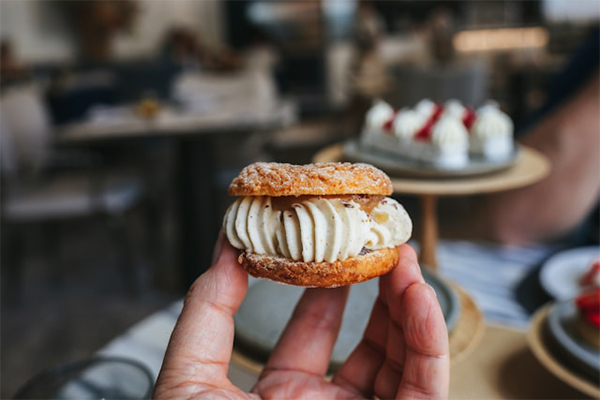
Definition: Steam-Leavened Pastry for Light, Hollow Shells
Choux pastry's high moisture content (from eggs and boiling water) creates steam, puffing the dough into crisp shells ideal for éclairs or cream puffs. When baked, the surface develops a glossy, caramelized crust with a matte, eggshell-like finish. The hollow interior has a slightly chewy texture, perfect for piping fillings like crème pâtissière. Its versatility extends to savory gougères (cheese puffs), making it a pastry shop favorite.
Ingredients
250ml water
125g butter
150g flour
4 large eggs
How to Make
Boil water and butter, then stir in flour to form a roux. Cool slightly, then mix in eggs using a stand mixer until glossy. Pipe into shapes and bake at 190°C (375°F) for 25 minutes.
Filo Pastry
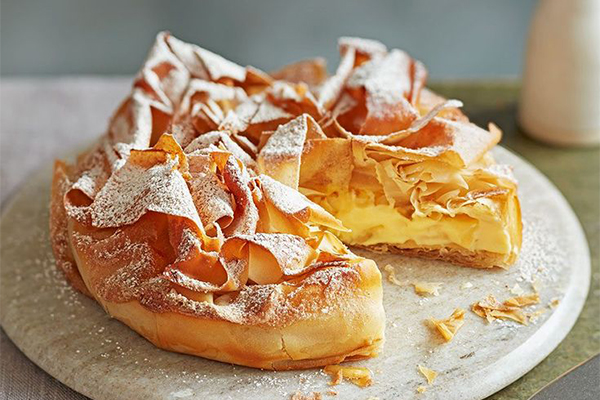
Definition: Paper-Thin Sheets for Sweet and Savory Applications
Common in baklava and spanakopita, filo (phyllo) pastry requires skill to handle. Unlike puff pastry, filo uses minimal fat between layers, resulting in a shatteringly crisp texture. When baked, the sheets turn translucent amber with a delicate, lace-like appearance. Each layer remains distinct, creating a flaky yet fragile structure. Its neutral flavor absorbs syrups or savory juices, making it ideal for high-moisture fillings in commercial kitchens.
Ingredients
Pre-made filo sheets (time-saving for commercial kitchens)
Melted butter (50g per 10 sheets)
Fillings: nuts, honey, spinach, feta
How to Make
Brush each filo sheet with butter, layer 8–10 sheets, add filling, and bake at 180°C (356°F) until golden.
Shortcrust Pastry
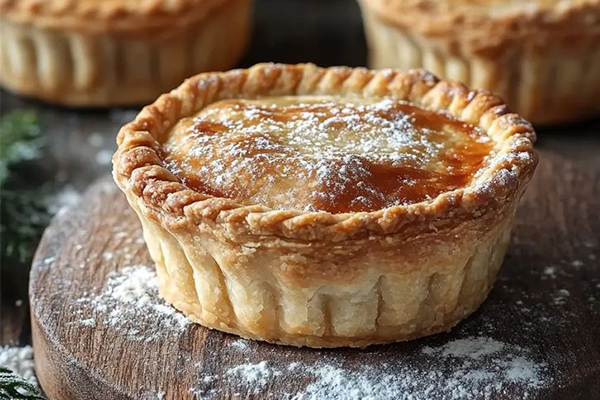
Definition: Sturdy, Crumbly Dough for Structural Integrity
With a 2:1 flour - to - fat ratio, shortcrust pastry (pâte brisée) is ideal for fruit tarts or quiches. Its minimal gluten development prevents shrinkage. When blind - baked, it achieves a sandy, melt - in - the - mouth texture with a pale golden color. The edges hold sharp fluted shapes, while the base remains flat and even, critical for pastry shops presenting sleek tart displays.
Ingredients
300g flour
150g chilled butter
60ml ice water
3g salt
How to Make
Use a food processor to pulse flour and butter into crumbs. Add water, shape into a disc, and chill. Roll to 4mm thickness for blind baking at 190°C (374°F).
Croissant Dough
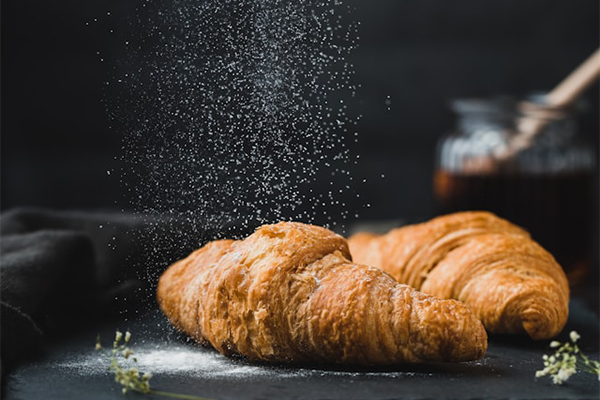
Definition: Layered Mastery with Buttery Aromas
Croissant dough combines yeast fermentation and lamination for a hybrid texture—crisp outer layers with a honeycombed, tender interior. When baked, it develops a rich mahogany color and distinct crescent shape. The aroma of fermented butter dominates, while the crumb pulls apart in feathery strands. For commercial kitchens, using a dutch crunch sheeter ensures uniform 3mm layers.
Ingredients
500g bread flour
300g butter (84% fat for optimal layering)
150ml cold milk
10g yeast
50g sugar
10g salt
How to Make
Mix dough, rest, then laminate with butter using a dough brake. Fold 3x, chill, shape into crescents, proof until doubled, and bake at 200°C (392°F) for 18 minutes.
Flaky Pastry
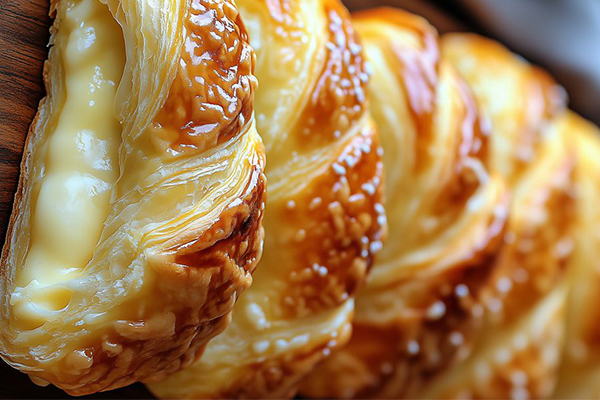
Definition: Quicker Alternative to Traditional Puff
Flaky pastry uses a "rough" lamination method, creating uneven, rustic layers. Baked goods like sausage rolls develop a golden - brown, blistered surface with thick, buttery flakes. The crumb is denser than puff pastry but offers a satisfying crunch, ideal for commercial kitchens needing faster production.
Ingredients
500g flour
300g cold butter (cut into 1cm cubes)
150ml ice water
5g salt
How to Make
Toss butter cubes into flour, add water, and roll/fold 4x. Bake at 190°C (374°F) for 20 - 25 minutes.
Hot Water Crust Pastry
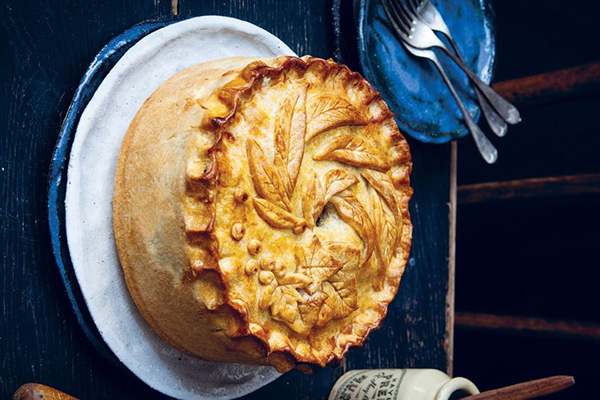
Definition: Durable Shell for Heavy Fillings
Used in traditional British pork pies, this pastry forms a sturdy, edible container. The dough has a biscuit-like texture—firm yet crumbly—with a deep golden - brown finish. Its high-fat content (lard or butter) creates a waterproof barrier, perfect for juicy meat fillings in pastry shop deli displays.
Ingredients
500g flour
200ml boiling water
200g lard
10g salt
How to Make
Melt lard in boiling water, mix into flour, knead while warm, and mold into pie shapes. Bake at 180°C (356°F) for 40 minutes.
Rough Puff Pastry
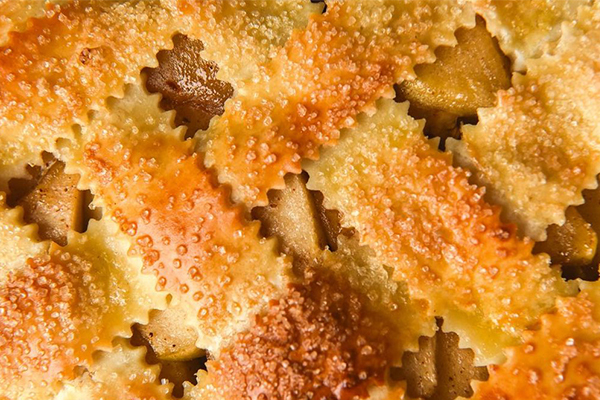
Definition: Time-Saving Layers for Small Batches
A hybrid of flaky and puff pastry, rough puff skips precise laminating. The result? Irregular, jagged layers with a rich butter flavor. It browns unevenly, creating a rustic appearance ideal for commercial kitchens producing galettes or quick-service pastries.
Ingredients
500g flour
300g butter (grated)
150ml of ice water
5g salt
How to Make
Grate cold butter into flour, mix, and roll/fold 4x. Bake at 200°C (392°F) for 15 - 20 minutes.
- What's the difference between filo and puff pastry?Filo has paper-thin, unleavened layers brushed with butter, while puff pastry uses laminated, leavened dough for thicker, airy flakes.
- Which pastry is best for high-volume kitchens?Pre-made rough puff pastry saves time, while shortcrust and choux adapt well to batch production with mixers and sheeters.
- How do I prevent puff pastry from shrinking?Chill dough between folds and use a perforated baking mat to allow even heat distribution.
- What essential kitchen equipment is needed to open a bakery?Dough sheeter for handling puff pastry and croissant dough
Planetary mixer for quickly making shortcrust and choux pastry
Proofing cabinet to control the humidity of croissant dough fermentation
Pastry blender to ensure even mixing of butter and flour
Perforated baking mats to prevent flaky pastry from becoming soggy on the bottom
Commercial deck oven for precise control of filo pastry's crispiness
- Are you manufacturer?Yes,we are half manufacturer half trading company. Manufacturing Furnotel brand equipment, trading for all kinds of kitchen equipment,especially turn-key solution.
- Do you have installation service?Yes, we have engineer team for installation instruction, but it will be extra charged.
- Do you keep stock?For Furnotel elegant series,snack equipment, usually we keep stocks, it can be delivered in 10 days. Pls leave message to ask for stock list.
- What kind of kitchen project can you do?We can provide A to Z solution to various kitchen,more than 2800 cases, such as hotel project,restaurant,bakery shop, fast food shop, cateen, central kitchen,café. Pls leave message to ask for reference book.
- Where are your customers located?We've provided service to more than 120 countries,pls leave message to ask for customer map.

Since Shinelong was established in Guangzhou in 2008, we have made great strides in the fields of commercial kitchen planning and kitchen equipment manufacturing.
IF YOU HAVE ANY QUESTION,PLEASE CONTACT US.
WhatsApp: +8618902337180
WeChat: +8618924185248
Telephone: +8618924185248
Fax: +86 20 34709972
Email: info@chinashinelong.com
After-Sales Contact
Telephone: +8618998818517
Email: service@chinashinelong.com
Add: No. 1 Headquarters Center, Tian An Hi-tech Ecological Park, Panyu Avenue, Guangzhou, China.


















